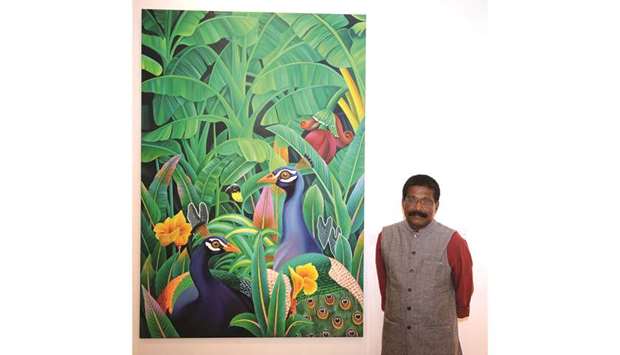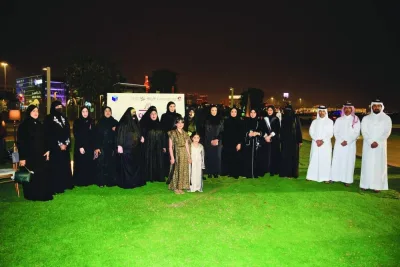His creativity earned him his first livelihood. He used to draw frogs, cockroaches, and human body parts for his class fellows in college and charge two rupees for each figure. The young artist used to spend the money to buy clothes, books and other necessities to carry on his studies.
Sixty-year-old Murali Nagapuzha is from Kerala in India. He is now an established artist organising solo exhibitions in major world cities. Pulling himself from abject poverty and equipping himself with a bachelor’s degree in botany and zoology, he managed to teach himself the art of painting.
‘Expression of Green’ is the name of the exhibition brought by Murali to Doha, which was formally launched on March 18 at Building 5 in Katara. The solo exhibition was arranged in connection with Qatar-India Cultural Year 2019.
The artist has brought his works highlighting the flora and fauna of Kerala. His paintings have an overriding green imprint — different plants, trees, streams and birds artistically drawn on canvas.
Community caught up with the artist to glean his artistic journey.
Introducing himself, Murali said: “We are 10 siblings. I have six sisters and three brothers. I figure in at nine. I come from a very small village called Nagapuzha. My father was an artisan, sculptor and metal worker. Traditionally, we are artists. You can say that we are genetically artists. I have not studied arts, but art is in my blood.
“My wife works in the Electricity Board in Kerala. We have two children; the older one is 17 and studying in Grade-XII while the younger is 10. My education has been a great help throughout my life. After my degree, I wandered across India looking for a job. I have done almost all odd jobs in different cities, mainly in Chennai. I even sold hand-made medicines in the streets. I also worked as a hotel boy.”
When asked how he developed an interest in art, Murali said: “It started with my father. I spent my childhood being very close to my father. I used to play with clay as we had no toys. So, art and life were not different for us. It was our livelihood.
“I was popularly known as an artist during my college days in the early ‘70s. I was very good at drawing. If my college needed some painting, the principal would call me. In botany, we had to draw so many different things. But the majority of fellow students did not know how. I used to draw frogs and cockroaches for them. I used to charge two rupees for one piece. They were always ready to pay. Though I came from a poor family, I used to be rich in college and able to buy the necessary things.
“I was actually made an ‘artist’ by my college friends as they used to call me an artist. (You could say) I was forced to become an artist. Since then, I have been exhibiting my work regularly. I have exhibited my works in major world cities. This is the third time that I am in Qatar.
Murali is inspired by nature and an advocate for green environment. He said: “My real inspiration comes from my village background. My village was lush green. What I paint is from the reality of my village. Actually, these [paintings] are all my childhood memories.
“Why do I paint my childhood memories? (It is because) after all these years, our green environment is fast disappearing. As a child, I used to see so many butterflies and many kinds of birds. Now, these have all gone. But the problem is not confined to my village; it is an issue with the whole world. The environment has become totally polluted. Water is also polluted. When I was a child, we used to fetch water from a river. Now, we cannot. Water has actually become poisonous. There is very little oxygen without poison in my country.
“This concerns me. It has made me conscious of our environment, and flora and fauna. We should give serious consideration to these issues. We cannot live without a clean environment. These thoughts push me for continuing my art work.
“The meaning of green for me is fertility, rejuvenation, and growth. I want people to protect the green environment.”
When asked what techniques he employs to paint, he said: “I only use oil colours. I feel they are the best medium. I follow the methodology that the masters have been doing — that is from opaque to light. I do layer work. I create different layers. It needs a lot of time. I will create a new layer only after the first one is dried. My work contains five to six layers at minimum. Whenever I feel that the colour is nice and it takes the very shade that is in my mind, I will stop painting.
“Formerly, I was an abstract painter. Now, I am a realist. I wish to combine abstract and realism in my works in future. That is my next project. The exposure to work from other countries has enlightened me.”
When asked to shed some light on the art scene in India, Murali said: “In the art market, some thirty years ago, there was a boom. Now, it has fallen. However, there are still many young artists from India making a name for themselves in the world. India is a very promising country when it comes to art, especially contemporary art. There are many great art institutions flourishing in India. Art students are coming out with newer vision and ideas.”
When asked to share one particular advice for aspiring artists, he said: “I am not a person who can advise other artists. I am still a student. However, I would like to say one thing that you should paint what you know. You should not paint a fact that you are not aware of. You should paint your personal experiences and imagination. When you are in Mumbai, paint Mumbai, not New York.
“Painting is a daily process. It is not like any other art form. We have to do the work continuously. There should be some kind of discipline for that. There should not be a break. You should work hard — I would say, like a bull. Do not look for success. It will come automatically.”
Commenting on the art scene in Qatar, he said: “It is fantastic. Now, Doha has become a centre for contemporary art. Earlier, Doha used to be seen as an Islamic cultural centre. (But now) it has become a hub of art activities. You can see well-known artists and their work here. I am so happy to be here and see the positive attitude of people towards art.
“Art connects. Art is the only source that can connect different people and different countries. The Government of Qatar knows that. They know the value of art. May be that is why you can see people from different countries here.”

MANTRA: Murali Nagapuzha draws his inspiration from nature. Photos by Shemeer Rasheed


